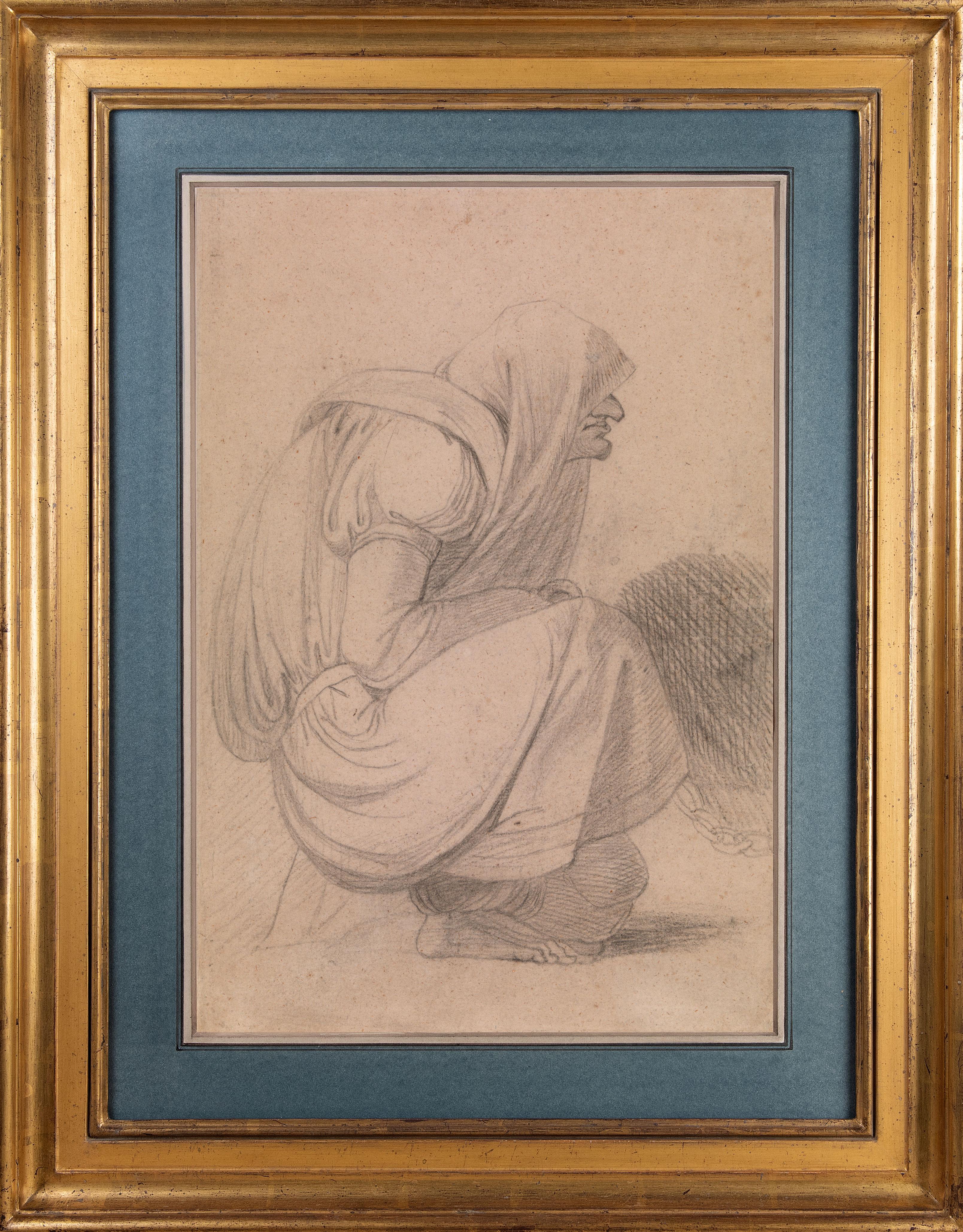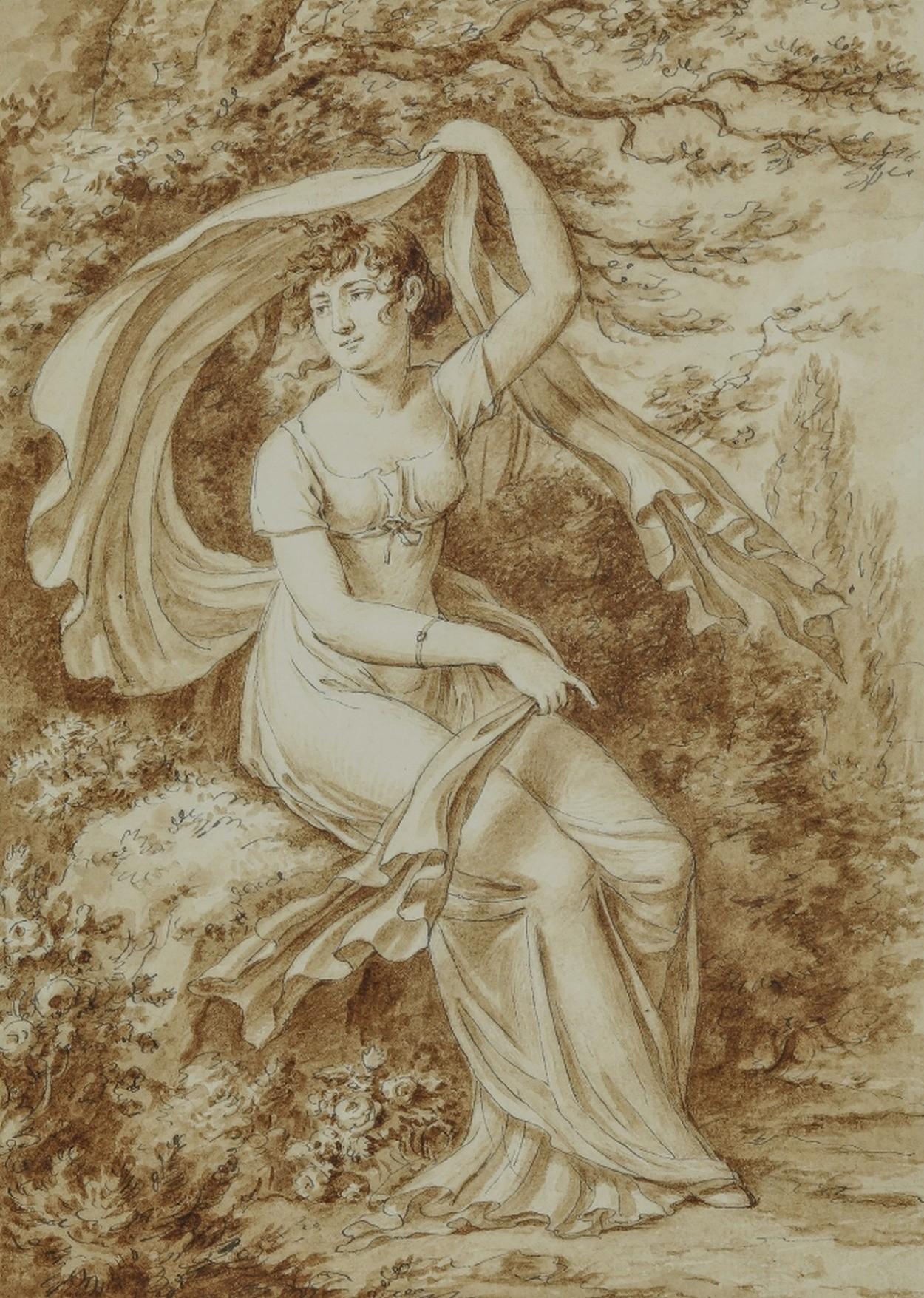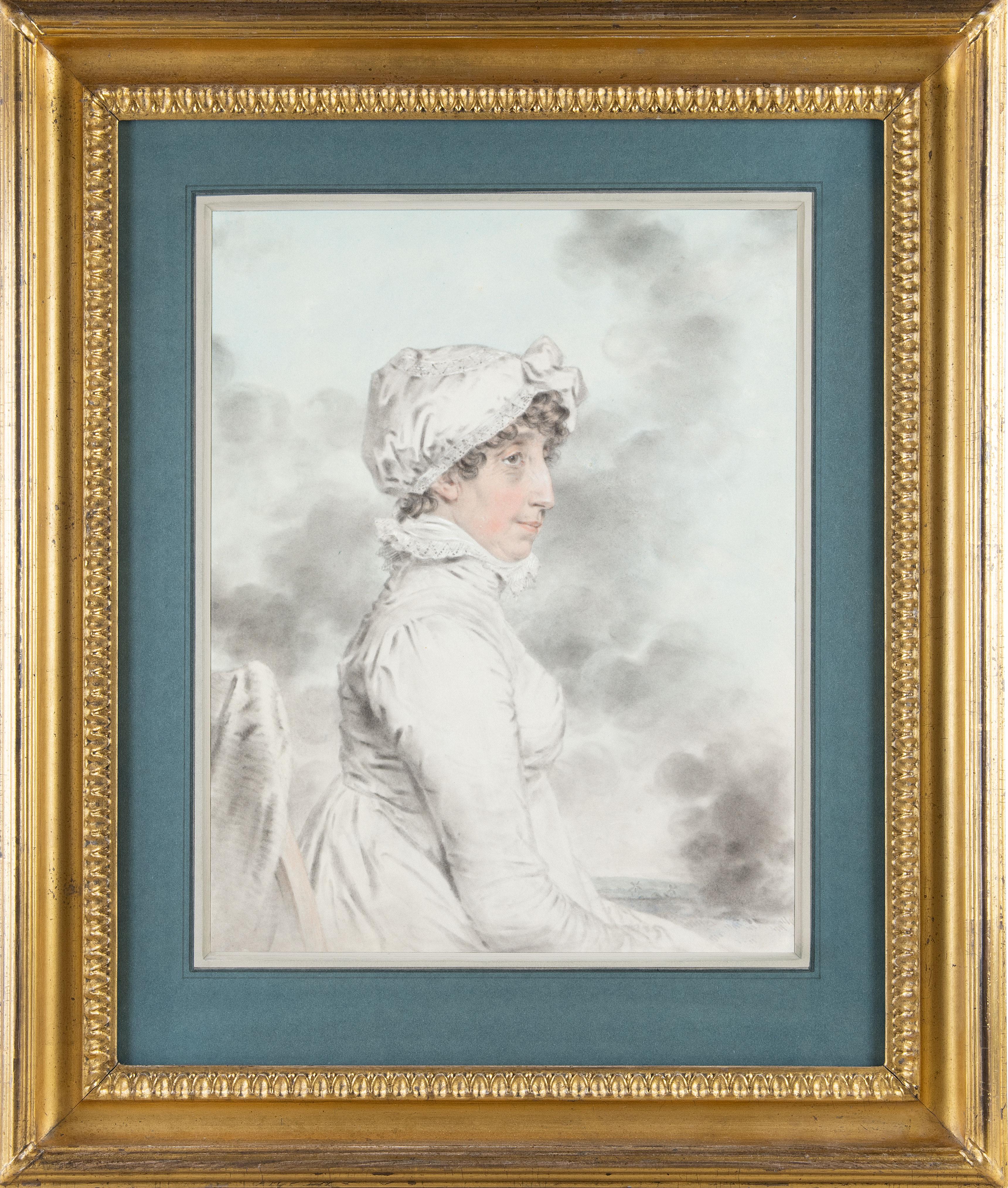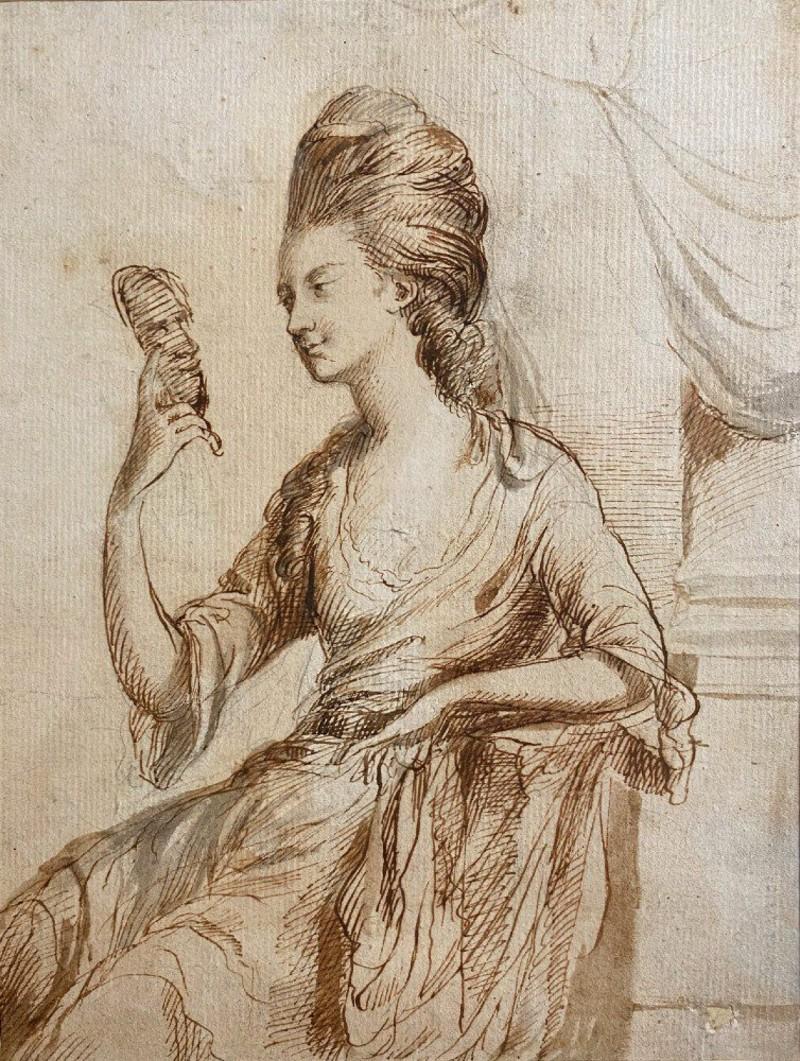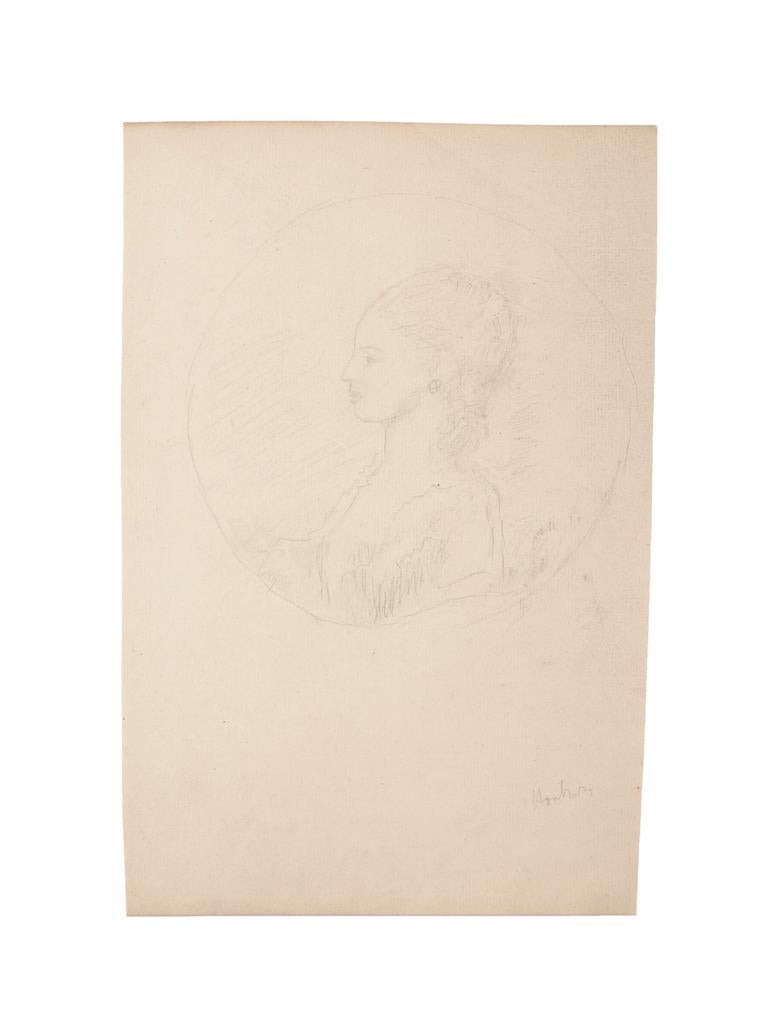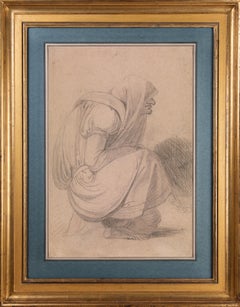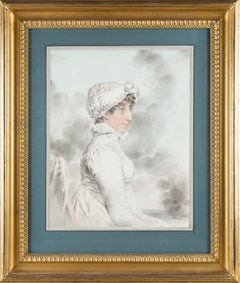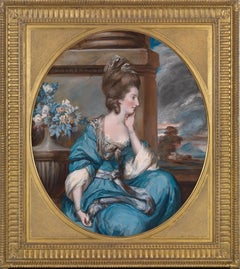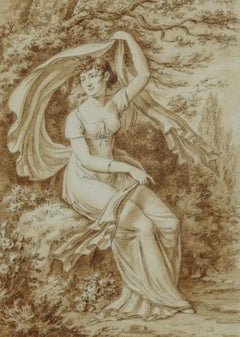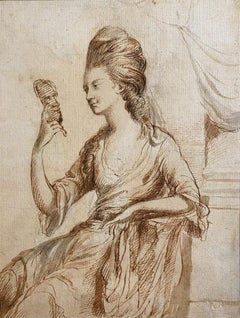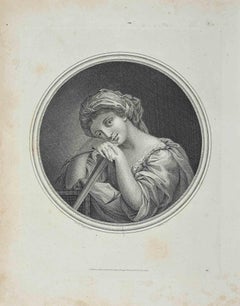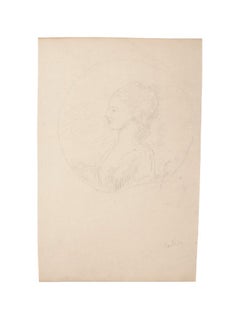Items Similar to Portrait drawing of Harriot Mellon, Mrs Thomas Coutts
Want more images or videos?
Request additional images or videos from the seller
1 of 6
Henry FuseliPortrait drawing of Harriot Mellon, Mrs Thomas Coutts1815
1815
$32,935.45
£24,000
€28,218.96
CA$45,474.80
A$50,428.20
CHF 26,496.28
MX$616,146.84
NOK 331,504.56
SEK 311,173.67
DKK 210,660.10
About the Item
Inscribed by the artist in pen and brown ink, upper margin: 'σοφὴν δὲ μισῶ: μὴ γὰρ ἔν γ' ἐμοῖς δόμοις / εἴη φρονοῦσα πλείον' ἢ γυναῖκα χρή [Euripides, Hippolytus, 11, 640-41: “But a clever woman - that I loathe! May there never be in my house a woman with more intelligence than befits a woman!”]; inscribed and dated, lower margin, H[arriot]. M[ellon]., and, S[omerset]. H[ouse]. may 29. [18]15.; and inscribed on the verso, Covent Garden Theatre / Admit seven to my box / T. Coutts / Saturday May 13th 1815'
Collections:
Sir Thomas Lawrence PRA, acquired from Fuseli’s estate;
Susan Coutts, Baroness North and Countess of Guilford (d. 1837), acquired in 1830 from Lawrence’s estate;
Susan, 10th Baroness North, daughter of the above (d. 1884);
North sale, Sotheby’s, 14 July 1885, lot 654 (one of six autographs “mostly with sketches”), bought by Harvey, £1.10s;
Ralph Edward Lambton;
Christie’s, 9 December 1980, lot 275;
Stanley J. Seeger.
Framed dimensions: 15.50 x 13 inches
This highly worked, intelligent and incisive portrait was made by Henry Fuseli in his rooms at the Royal Academy in Somerset House. The subject was the celebrated actress, Harriot Mellon, who had recently married Fuseli’s great friend and patron, the banker, Thomas Coutts. Coutts had sponsored Fuseli’s trip to Rome in 1770 and remained a life-long support of the artist and his work. This powerful, carefully observed profile portrait is a testament to the intimacy between Fuseli and Coutts.
The daughter of itinerant actors, Mellon, famous for her beauty, made her debut in London at the Drury Lane Theatre as Lydia Languish in Sheridan's The Rivals in 1795. Anne Matthews, a fellow actress described her as: ‘a young, glowing beauty, endued with great natural powers of mind, talents and vivacity, but ... an insuperable rusticity of air and manners.’ Mellon retired from the stage in February 1815, shortly after her marriage to Coutts, he was seventy-eight, forty years older than Mellon.
Fuseli produced a number of intense studies of women throughout his career. Frequently fantastical and eroticized, these drawings often show women at their toilet, dressing their hair or in a state of undress. This intensely worked sheet preserves something of Fuseli’s interest in women’s hair. Her hair is worked with a graphic intensity which recalls both Etruscan vase painting and the spare line engravings of John Flaxman. The drawing is inscribed with the date and location ‘S.H.’ referring to Somerset House, the home of the Royal Academy, where Fuseli had a studio in his capacity as Keeper of the Royal Academy Schools. In a characteristic mode, Fuseli has also inscribed the drawing with two lines of Greek. The quotation comes from Euripides’s Hippolytus and translates as: ‘But a clever woman - that I loathe! May there never be in my house a woman with more intelligence than befits a woman!’ The ambiguity of this sentiment is entirely typical of Fuseli’s deployment of text within his images, but it may also point to a dissatisfaction at seeing his oldest friend and patron marry an actress in old age?
With sparse use of his media and without unnecessary embellishments, Fuseli captured the extrinsic features as well as the character of his sitters. One of the young women Fuseli frequently portrayed at the time was Lavinia de Irujo, daughter of a Spanish diplomat, then living in Chelsea. She, like one of Coutts’s grand-daughters, Lady Georgina North, had received drawings lessons from the artist. Two portraits of Lavinia, made in 1813 and 1814, respectively, are particularly close in style and type to our sheet. The earlier one shows Lavinia with an almost identical coiffure, her name inscribed in Greek letters. Fuseli often inscribed his drawings in Greek; a characteristic sheet comparable to ours is a drawing of a courtesan, identical in style, medium and size, in the Kunsthalle, Hamburg, which bears a similar two-line Greek inscription, this time quoted from Homer’s Iliad.
Fuseli lived in some intimacy with the Coutts family. He would often stay with Susan, Coutts’s eldest daughter, then Countess of Guilford, at her house in Putney Hill; in that familial context Fuseli made many of his intimate portrait drawings, and it was there that Fuseli, surrounded by the adoring members of the Coutts family and other friends, such as Thomas Lawrence, died in 1825. All of Fuseli’s drawings and sketches, including the present sheet, were then purchased by Lawrence, and after his death entered the possession of the Countess of Guilford, through whose family they descended.
- Creator:Henry Fuseli (1741 - 1821, Swiss)
- Creation Year:1815
- Dimensions:Height: 7 in (17.78 cm)Width: 4.5 in (11.43 cm)
- Medium:
- Movement & Style:
- Period:
- Condition:Preserved in excellent condition and housed in a giltwood frame.
- Gallery Location:London, GB
- Reference Number:1stDibs: LU150727722312
About the Seller
5.0
Recognized Seller
These prestigious sellers are industry leaders and represent the highest echelon for item quality and design.
1stDibs seller since 2021
5 sales on 1stDibs
- ShippingRetrieving quote...Shipping from: London, United Kingdom
- Return Policy
Authenticity Guarantee
In the unlikely event there’s an issue with an item’s authenticity, contact us within 1 year for a full refund. DetailsMoney-Back Guarantee
If your item is not as described, is damaged in transit, or does not arrive, contact us within 7 days for a full refund. Details24-Hour Cancellation
You have a 24-hour grace period in which to reconsider your purchase, with no questions asked.Vetted Professional Sellers
Our world-class sellers must adhere to strict standards for service and quality, maintaining the integrity of our listings.Price-Match Guarantee
If you find that a seller listed the same item for a lower price elsewhere, we’ll match it.Trusted Global Delivery
Our best-in-class carrier network provides specialized shipping options worldwide, including custom delivery.More From This Seller
View AllDrawing of a captive woman
By Henry Fuseli
Located in London, GB
Collections:
Sir Thomas Lawrence, who acquired the contents of Fuseli’s studio;
Susan, Countess of Guilford, née Coutts (1771-1837), acquired from the Lawrence estate;
Susan, Baroness North (1797-1884), daughter of the above;
Mrs A. M. Jaffé, acquired in France, c. 1950 to 2016.
Black chalks, on buff-coloured paper
Stamped verso: ‘Baroness Norths Collection / of Drawings by H Fuseli Esq.’
Framed dimensions: 26.38 x 20.63 inches
This boldly drawn sheet depicting a seated figure was made by Fuseli at an important and highly productive moment in his career. The monumental drawing is closely related to another sheet by Fuseli in the British Museum which Schiff published as subject unknown. Both drawings were made when Fuseli was designing his most important sequence of historical works, including scenes from Shakespeare and Milton, The Nightmare and The Death of Dido which was exhibited at the Royal Academy to great critical acclaim in 1781. The present drawing does not relate directly to any of Fuseli’s finished historical paintings of the period, but evidently the image of a slightly menacing, seated and covered old woman was precisely the sort of motif he was playing with. It is notable that the same figure reappears later in Fuseli’s work as the witch from Ben Jonson’s Witch’s Song which Fuseli produced as both a painting and engraving in 1812.
Fuseli returned to London in 1779 from a highly creative and productive period in Rome and established himself as one of the leading history painters of the period. Fuseli re-established contact with his old mentor Sir Joshua Reynolds, becoming a regular guest at his dinner table and visitor to his studio. The earliest and most striking manifestation of this strategy was Fuseli's Death of Dido, exhibited in 1781 at the Royal Academy. Executed on the same scale as Reynolds's version (Royal Collection), Fuseli's vertically oriented picture was hung directly opposite Reynolds's with its horizontal orientation, inevitably inviting comparison between the two works and garnering Fuseli much publicity and favourable reviews in the newspapers.
The present, previously unpublished sheet, relates closely to a drawing now in the British Museum. That sheet shows the same seated old woman, drawn on a smaller scale and more schematic in design, seated next to an anatomical drawing of a man. The pose of this figure is related to the pose of Dido in his Death of Dido; the foreshortened torso, arrangement of head, oblique view of Dido’s features and arms all suggest that the study can be viewed as an initial thought for the composition. Fuseli may have initially thought of including the figure of the hunched and covered old woman. Drawn on identical paper to the British Museum sheet, our study is an enlarged depiction of the same figure, more elaborately delineated and developed. The presence of a chain to the right of the figure, suggests that the iconography was related in some way to a scene of imprisonment.
Fuseli had first explored the motif of the hooded old woman in an early Roman drawing, 'The Venus Seller'. The idea of a grotesque old woman, hooded and with angular nose and projecting chin seen in profile was most spectacularly used by Fuseli in his sequence of paintings depicting The Three Witches from Macbeth. Fuseli seems to have kept the present sheet and may have returned to it when preparing a painting of The Witch and the Mandrake from Ben Jonson’s Witch’s Song from his Masque of Queens in 1812. Here the same seated figure looks out from under her hood and picks a mandrake by moonlight. Jonson’s drama had been performed at the court of James I in 1609, inspired the subject. To throw the nobility of the queens into relief, the poet added a coven of witches, one of whom declares: ‘I last night lay all alone, On the ground, to hear the mandrake groan; And plucked him up, though he grew full low, And, as I had done, the cock did crow.’ The figure was reversed in the associated etching which was published in 1812. It seems likely that the present drawing remained as part of Fuseli’s working archive of figure studies.
The present drawing was presumably purchased with the bulk of Fuseli’s drawings after the artist’s death by Sir Thomas Lawrence. Lawrence’s large group of Fuseli drawings were then acquired by Susan, Countess of Guildford (1771-1837). Lady Guildford was the eldest daughter of the banker Thomas Coutts (1735-1822), who himself had supported Fuseli’s journey to Rome in the 1770s and had remained one of the artist’s key...
Category
18th Century Old Masters Figurative Drawings and Watercolors
Materials
Chalk
Regency portrait drawing of Arabella Graham-Clarke
By John Downman
Located in London, GB
Collections:
The sitter, and by descent;
Christie's, 19th March 1928, lot 6;
Private collection to 2019
Literature:
G.C. Williamson, John Downman, A.R.A., his Life and Works, Lon...
Category
Early 19th Century Old Masters Portrait Drawings and Watercolors
Materials
Pencil, Watercolor
Regency portrait drawing of Lady Nugent
By John Downman
Located in London, GB
Collections:
With Ellis Smith, London;
Private collection, to 2015.
Literature:
G.C. Williamson, John Downman A.R.A., his Life and Works,
p. lviii no...
Category
19th Century Old Masters Portrait Drawings and Watercolors
Materials
Pencil, Watercolor
Portraits of the Hon. Mary Shuttleworth and Anna Maria, 9th Baroness Forrester
By Daniel Gardner
Located in London, GB
THE HON. MARY SHUTTLEWORTH, NÉE COCKBURN (D. 1777)
and her sister
ANNA MARIA, 9TH BARONESS FORRESTER (D. 1808)
Pastel and gouache on paper laid on canvas, on their original backb...
Category
18th Century Old Masters Portrait Drawings and Watercolors
Materials
Pastel, Gouache
18th century pastel portrait of Lady Augusta Corbett and her son, Stuart
By Daniel Gardner
Located in London, GB
Collections:
Commissioned by Andrew Corbett, husband of the sitter;
The Venerable Stuart Corbett;
Sir Stuart Corbett;
By descent to 2002;
Sotheby’s, London 21 March 2002, lot.104;
Lowell Libson...
Category
18th Century Old Masters Portrait Drawings and Watercolors
Materials
Pastel, Gouache
Eighteenth century Old Master drawing - St Jerome
By John Hamilton Mortimer
Located in London, GB
Pen, ink and wash
Framed dimensions: 9 ½ x 11 ¼ inches
Drawn c. 1763
This small, powerful study shows St Jerome contemplating the bible with a cross and sk...
Category
18th Century Old Masters Figurative Drawings and Watercolors
Materials
Ink, Pen
You May Also Like
Jean-Henri Cless (1774-1812) Portrait of a young woman, signed drawing
Located in Paris, FR
Jean-Henri Cless (1774-1812)
Portrait of a young woman in a landscape
signed "Cless fec" for fecit on the lower left
Brown ink and brown ink wash on paper
Size of the sheet : 31.5 x 22 cm
Size of the motive : 24.5 x 17 cm
very simply framed under glass without actual frame 32 x 22.5 cm
This pre...
Category
Early 1800s Old Masters Portrait Drawings and Watercolors
Materials
Ink, Pencil
Portrait of Lady, 18th Century English Pen and Ink
By Ozias Humphry
Located in London, GB
Ozias Humphry
1742-1810
Portrait of Frances Abington
Pen and brown ink on paper
Image size: 7 1/2 x 5 3/4 inches
Giltwood frame
The actress Frances (Fanny) Barton, better known as M...
Category
18th Century Portrait Drawings and Watercolors
Materials
Ink, Pen
Portrait of Woman - Original Etching by Thomas Holloway - 1810
By Thomas Holloway
Located in Roma, IT
Portrait of Woman is an original artwork realized by Thomas Holloway (1748 - 1827).
Original Etching from J.C. Lavater's "Essays on Physiognomy, Designed to promote the Knowledge and the Love of Mankind", London, Bensley, 1810.
A the bottom center the name of the man portrayed "an angelic Woman...
Category
1810s Old Masters Portrait Prints
Materials
Etching
Portrait of Woman - Pencil on Paper - 19th Century
Located in Roma, IT
Portrait is a modern drawing in pencil on paper realized by an Anonymous artist of the 19th Century.
hand-signed on the lower righ, illegible.
Good conditions.
The artwork represen...
Category
19th Century Figurative Drawings and Watercolors
Materials
Pencil
Achille Devéria (1800-1857) A young woman seen in profile, original drawing
Located in Paris, FR
Achille Devéria (1800-1857)
A young woman seen in profile
Black Chalk on paper
with cut edges
Bears the stamp of the Achille Deveria Estate Sale of 1...
Category
1840s Romantic Portrait Drawings and Watercolors
Materials
Carbon Pencil
he Portrait Of a Young Woman - Etching by Thomas Holloway - 1810
By Thomas Holloway
Located in Roma, IT
he Portrait Of a Young Woman is an original etching artwork realized by Thomas Holloway for Johann Caspar Lavater's "Essays on Physiognomy, Designed to Promote the Knowledge and the ...
Category
1810s Modern Figurative Prints
Materials
Etching
More Ways To Browse
Portrait Of An Actor
Brown Line Drawing
Theatre Drawings
Erotic Drawings
Old Master Drawings Framed
Thomas Henry Thomas
Line Drawing Of Women
Old Master Sketch
19th Century Portraits Of Women
T Thomas Painting
Henry Hill
Old Master Pencil Drawing
Antique Vase Drawing
Portraits Actress Painting
M Henry Painting
Antique Portrait Box
Thomas Hill
Erotic Pencil Drawings
